
America Arms Herself and Her Allies
Copyright © Henry J. Sage, 2017
Reflections on a Mobilized Nation. I grew up near New York City during World War II and recall quite vividly many of the things that were taken for granted as part of the war situation. For example, people on the East Coast were concerned about the possibility, however remote, that we might be attacked from the air by Germany. Thus I recall regular air raid drills in our neighborhood. Responsible citizens would be designated air raid wardens, and when the sirens went off at the village firehouse, people were obliged to either turn off all their lights or completely pull down black shades that would prevent light from escaping. The neighborhood warden, wearing a protective helmet, would patrol the neighborhood on foot with a flashlight (all streetlights were turned off) and politely correct all those who perhaps allowed a small beam of light to escape from a window. On our block during warm weather the neighbors would sit on their porches smoking cigarettes and listening to the latest news on the radio. (Everybody smoked, and television had not yet arrived.)
In 1942 imposed rationing of certain goods control consumption of items critical for the war effort. Many commodities were rationed because the contents were needed to make explosives or provide for other war-related needs. Every family was given ration books containing stamps that had to be turned in to 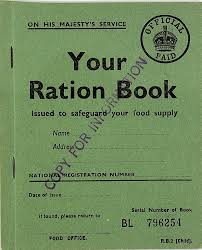 purchase coffee, sugar, meat, dairy products, lard, canned foods and many other items. Most carefully controlled was the rationing of rubber tires and gasoline, critical items needed by the armed forces. Pleasure driving was prohibited, automobile races were banned, and in order to qualify for ration coupons to purchase gasoline or tires , the automobile owner had to demonstrate that he or she worked in a war-related industry. Whenever my uncle, who worked for General Motors, was going downhill, he shifted his car into neutral and turned off the engine in order to save a little gas. Many car owners who did not need their cars for going to work simply put them up on blocks for the duration of the war. No new cars were produced, as all the automobile companies were making military vehicles.
purchase coffee, sugar, meat, dairy products, lard, canned foods and many other items. Most carefully controlled was the rationing of rubber tires and gasoline, critical items needed by the armed forces. Pleasure driving was prohibited, automobile races were banned, and in order to qualify for ration coupons to purchase gasoline or tires , the automobile owner had to demonstrate that he or she worked in a war-related industry. Whenever my uncle, who worked for General Motors, was going downhill, he shifted his car into neutral and turned off the engine in order to save a little gas. Many car owners who did not need their cars for going to work simply put them up on blocks for the duration of the war. No new cars were produced, as all the automobile companies were making military vehicles.
People saved bacon grease to take to the butcher shop to trade for extra meat. Margarine was introduced to replace butter—it came in a white plastic pack with a little bubble of dye that had to be squeezed and the contents kneaded to give it a yellow color. Many consumer goods were no longer produced. Companies that produced appliances such as washing machines turned to making weapons. The Ford Motor Company made airplanes and General Motors made tanks. The Singer Sewing Machine company made machine guns. Between 1942 and 1945 hardly any new civilian automobiles were built as the motor companies worked around the clock to turn out military vehicles and aircraft.
People were encouraged to buy war bonds, and announcements were made at the beginning of every showing in a movie theater. The movie industry cooperated with the Department of Defense to produce patriotic movies, and Hollywood made short subject films 10 or 15 minutes long to be shown in theaters, encouraging people to buy bonds, support the troops with encouraging mail and do everything they could to help the war effort. Weekends were frequently devoted to drives to collect old newspapers and tin cans that were delivered to a railroad car parked on the siding on the edge of our village. People were encouraged to economize by all possible means—nothing was to be wasted. We had meatless Tuesdays and Fridays, “victory gardens” grew everywhere, and families with sons, brothers or husbands in the services flew flags in their windows with a star for each serviceman. If a loved one was killed, the flag showed a gold star, and women organized “gold star mothers” group for consolation and support.
 Although people entered into the war effort with enthusiasm, there were nevertheless things like the black market. One meat market in our hometown allowed people to purchase meat beyond their ration allowance "for a price." If one had the right connections, it was possible to obtain almost any rationed item, and although the practice was frowned upon, enforcement of rationing restrictions was difficult.
Although people entered into the war effort with enthusiasm, there were nevertheless things like the black market. One meat market in our hometown allowed people to purchase meat beyond their ration allowance "for a price." If one had the right connections, it was possible to obtain almost any rationed item, and although the practice was frowned upon, enforcement of rationing restrictions was difficult.
To curb inflation, the government established the Office of Price Administration to put controls on prices of consumer goods. Since people had much higher incomes than in the latter depression years, and consumer goods were scarcer than ever, a recipe for inflation existed. Wages were also capped by the government. President Roosevelt was able to convince Congress that higher taxes were needed, and in fact both parties understood that the cost of the war required higher tax rates. During the course of the war the tax rates on the highest incomes rose as high as 94%, and executive pay in corporations dealing with the government were capped. In addition, thresholds for the payment of taxes were reduced, as were personal exemptions and deductions. In 1940 only 10% of working people paid income taxes; by 1944 almost everyone who worked was taxed.
Although the United States was fighting against what it saw as totalitarian regimes, the level of control that the government exercised over the American people was nevertheless astounding. The War Department had a motion picture section that was designed to influence what filmmakers could put on the screen that might affect the war effort. War films did not showed Americans being killed or wounded. In those pre-television days, people got their visual news from newsreels in movie theaters preceding the main attraction. In addition, patriotic messages were inserted into commercial films at the request of 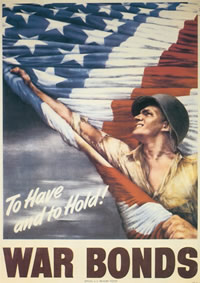 the Pentagon; film producers were glad to oblige. At the direction of the government, newsreels were not to show any pictures of American battlefield casualties until late in 1943. If those restrictions can be seen as thought control, the American people generally understood that it was for a good cause.
the Pentagon; film producers were glad to oblige. At the direction of the government, newsreels were not to show any pictures of American battlefield casualties until late in 1943. If those restrictions can be seen as thought control, the American people generally understood that it was for a good cause.
Huge rallies were held in theaters and parks for the sale of war bonds. Patriotic announcements in movie theaters preceded most films, asking people not to discuss troop movements; to buy war bonds; and to give moral support their fathers, sons, and husbands who were serving overseas. It was even considered unpatriotic for a woman to end a romantic relationship with a soldier overseas lest it damage his morale. A popular song written with servicemen in mind proclaimed that their women were being “good as gold” because all the men back home were “either too young or too old.” As schoolchildren we purchased savings stamps with our quarters, and when we had $18.75 pasted into our books, we took them to the bank or post office and turned them in for a $25 war bond.
Cartoons of Hitler, Tojo, and Mussolini were commonly seen alongside patriotic posters proclaiming that “Uncle Sam wants you!” It was a total war, and the entire population was involved. Because of the huge demand for workers in automobile, steel, and other plants that were vital to the war effort, workers in those industries were exempt from the draft. For a time the government contemplated drafting men to go to work in factories in war-related industries, but abandoned the idea because it might be a violation of civil rights.
American Industry at War
Historians have pointed out that World War II was won not only on the battlefields of North Africa, Europe, the Pacific Islands, and Asia, but that it was also won in Pittsburgh, Detroit, Birmingham, St. Louis, on the West Coast, and in all the other areas where the war industries were congregated. Beginning in the spring of 1942, factories ran twenty-four hours a day, six or seven days a week. Unemployment during the war dropped to slightly more than 1 percent of the working age population. Government spending during World War II in inflation adjusted (2008) dollars was 4.1 trillion dollars. The cost of all prior wars combined was $325 billion. In actual dollars it federal expenditures during the war were twice as much as was spent in all of American history to that point combined. By 1944 almost 90% of all government spending went to the war cause.
Women. The figure of "Rosie the Riveter" became a symbol for the expanded roles of women in the wartime economy as well as in society in general. They went to work in almost every industry and performed jobs that had previously been considered unsuitable or too difficult for women. A women's baseball 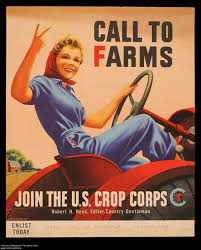 league was created to provide patriotic entertainment in the absence of other opportunities to relax. The All-American Girls' Professional Baseball League started slowly but became popular, and 40 years later it was inducted into the Baseball Hall of Fame in Cooperstown.The absence of men from the workforce and the demands of a wartime economy drew millions of women into paying jobs outside the home. Six million more women were working at the end of the war than at the beginning. Although resentment from male workers existed, over time as women proved themselves, and as the demands of war grew, such attitudes became rare. Government encouraged women to get into defense work by claiming, for example, that if a woman could use a sewing machine, she could operate a drill press. Women were soon at work building tanks, ships, guns, airplanes and other military equipment. “Rosie the Riveter” became an icon for female labor power. Although sex discrimination on jobs returned after the war, the expanding roles for women during the war were a source of inspiration in the later women’s liberation movement.
league was created to provide patriotic entertainment in the absence of other opportunities to relax. The All-American Girls' Professional Baseball League started slowly but became popular, and 40 years later it was inducted into the Baseball Hall of Fame in Cooperstown.The absence of men from the workforce and the demands of a wartime economy drew millions of women into paying jobs outside the home. Six million more women were working at the end of the war than at the beginning. Although resentment from male workers existed, over time as women proved themselves, and as the demands of war grew, such attitudes became rare. Government encouraged women to get into defense work by claiming, for example, that if a woman could use a sewing machine, she could operate a drill press. Women were soon at work building tanks, ships, guns, airplanes and other military equipment. “Rosie the Riveter” became an icon for female labor power. Although sex discrimination on jobs returned after the war, the expanding roles for women during the war were a source of inspiration in the later women’s liberation movement.
See also Women in World War II.
The quantity of goods and the speed with which they were produced astonished observers. The aircraft industry produced 324,750 planes during the war, with ever increasing efficiency. In 1941, production of a B-17 required 55,000 individual worker hours. By 1944 the figure was down to 19,000 hours. The Kaiser shipbuilding company turned out ships with amazing speed, and in one exercise just to prove a point, they actually constructed a vessel from the keel up in 4 days, 15 hours and 30 minutes. The ship, the SS Robert E. Peary, sailed seven days after the keel was laid.
The Boeing B-17 “Flying Fortress” was one of the great aircraft of World War II. With a crew of ten, the B-17G—one of the later models—could fly at up 300 miles per hour at 30,000 feet, carrying a bomb load of 8,000 pounds over a range of 1,850 miles. The aircraft could defend itself with thirteen .50-caliber machine guns, but bomber squadrons were generally accompanied by fighters for additional protection.
While the stout B-17 airplane could sustain considerable damage and keep on flying, more than 4,000 were lost from enemy action and other causes such as accidents in the European theater alone. One raid on Schweinfurt, Germany, in 1943 resulted in 60 bombers lost and 30 more damaged beyond repair. The highly trained crews were as hard to replace as lost aircraft, especially given the policy that after twenty-five missions over enemy territory, airmen would return to the States to train others.
Although there were those who profiteered from those sorts of things, and although a black market existed (a grocer in our village was happy to provide an extra ration of meat in exchange for a few extra dollars), most Americans simply accepted things as they were. Since silk and nylon had disappeared from stores—they were going into parachutes—women put makeup on their legs and traced with an eyebrow pencil what was meant to look like a seam on the back of their “stockings.”
Such was the devotion of the American people toward the war cause that one phrase frequently uttered when some thoughtless person was observed doing something not in the best interest of the country was: “Don’t you know there’s a war on?!” It was everybody’s war. If a family existed that wasn’t touched in some way or other by the enormous effort put forth to win World War II, that family was probably very isolated from the rest of American society.
Labor Issues. Labor issues were critical in every facet of the American economy, from agriculture to industrial work. Farming suffered when agricultural workers moved to cities to seek higher-paying jobs in factories. At the same time, the demands for food by the military and to support civilian populations of overseas countries required the government to take steps to increase production. Even German and Italian prisoners of war were assigned to work on farms under guard. The unions grew considerably stronger during the duration of the war. Concerns were raised over the possibility of strikes, and everything was done by the government and corporations to avoid shutdowns. Employers compensated for the freezing of wages by offering untaxed benefits such as health insurance or vacation packages. The largest unions supported the notion of a promise not to allow strikes that might impede the production of vital materials. As unions grew stronger, the leadership also gained power, and they made accommodations to the war environment by welcoming women into unions.
Internment of Japanese Americans. The fear and anger generated by the Japanese attack on Pearl Harbor led to one of the sorriest episodes in American history. Although there was no call for instant retribution against Japanese Americans in the weeks immediately following the attack, continued Japanese advances and victories raised fears on the West Coast that the Japanese might attempt an attack on the American mainland. In Hawaii, where approximately half of the population were Japanese, any attempt to exert mass controls over the Japanese population would have been impossible. Individual arrests were made in Hawaii, however, of persons suspected of actual espionage activity.
 On the West Coast of the United States, however, the situation was different in that the population of Japanese-Americans, whether immigrant or foreign-born, was approximately 120,000, a much smaller percentage of the total population than was the case in Hawaii. Occasional reports of enemy aircraft or submarines off the California coast helped to generate fear and suspicion of the Japanese population. Because the West Coast was considered vulnerable to attack, responsibility for the security of the Western states was turned over to the Army.
On the West Coast of the United States, however, the situation was different in that the population of Japanese-Americans, whether immigrant or foreign-born, was approximately 120,000, a much smaller percentage of the total population than was the case in Hawaii. Occasional reports of enemy aircraft or submarines off the California coast helped to generate fear and suspicion of the Japanese population. Because the West Coast was considered vulnerable to attack, responsibility for the security of the Western states was turned over to the Army.
Amid fears that espionage against the U.S. might be carried out, President Franklin Roosevelt signed Executive Order 9066 on February 19, 1942. The Order authorized commanders of military areas to exclude “any or all persons” from designated areas. Attorney General Francis Biddle and others vehemently opposed the detention of Japanese Americans, but pressure from editorials, California officials, including Governor Earl Warren, spread rapidly. General John L. DeWitt, Commander of the Western District, reported that radio signals were being transmitted from the West Coast to inform Japanese submarines of American ship movements. (See David M. Kennedy, Freedom from Fear: The American People in Depression and War, 1929-1945, New York: Oxford University Press, 1999, 748-760.)
The FBI and other intelligence agencies determined that reports of suspected espionage activities were false, FBI Director J. Edgar Hoover, who opposed the internment of Japanese Americans, wrote to Attorney General Biddle that all reports had been investigated, “but in no case has any information been obtained which would substantiate the allegation." General DeWitt, who had initially opposed relocation of the Japanese, nevertheless initiated the order to remove all Japanese from the West Coast. Although Secretary of War Stimson recognized that the rights of some loyal citizens would be violated, he authorized the operation.
Thousands of Japanese were loaded onto buses and railroad trains and moved to internment camps or relocation centers throughout the Western states. They were permitted to take only a few belongings, and the departures were wrenching, as looters frequently pillaged Japanese homes and businesses even as the owners were leaving. Japanese who wish to were allowed to leave the West Coast voluntarily, and some 15,000 went to live with friends or relatives in other parts of the country.
Although their existence in the camps did not involve overt forms of harassment or harsh treatment, the Japanese, including many native-born American citizens, were nevertheless imprisoned. Conditions in the camps varied from wretched to tolerable. To Japanese printed newspapers and created a normal facilities like schools, fire and police departments. The internees were permitted to farm in the area surrounding the camps. As the war progressed, young Japanese men and women were permitted to join the Army. In the course of the war over 20,000 Japanese American men and women served in the U.S. Army. One group of Japanese soldiers comprised the famous 442nd Regimental Combat Team. They fought in Europe and were one of the most highly decorated American units in the war.
In 1944 the Supreme Court ruled on the issue of Japanese in the case of Korematsu v. United States. Fred Korematsu refused to obey Executive Order 9066; He was arrested, tried, and convicted and appealed his case to the Supreme Court on the grounds that the Order was unconstitutional. The Court upheld the order by a vote of 6-3, stating that Korematsu was excluded from the restricted area “because we are at war with the Japanese Empire.” Under the 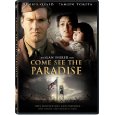 circumstances, the Court said, the military had the right to take what they considered necessary precautions. Justice Frank Murphy dissented from the majority decision. He called the exclusion of Japanese comparable to Germany's racist policies. He said, "I dissent, therefore, from this legalization of racism. Racial discrimination in any form and in any degree has no justifiable part whatever in our democratic way of life."
circumstances, the Court said, the military had the right to take what they considered necessary precautions. Justice Frank Murphy dissented from the majority decision. He called the exclusion of Japanese comparable to Germany's racist policies. He said, "I dissent, therefore, from this legalization of racism. Racial discrimination in any form and in any degree has no justifiable part whatever in our democratic way of life."
An excellent 1990 film, “Come See The Paradise,” starring Tamlyn Tomita and Dennis Quaid, directed by Alan Parker, tells the story of a Japanese family who were moved to an internment camp.
The internment ended in January 1945, although the war was still on. Fred Korematsu’s conviction was eventually overturned. In 1988 and 1992 civil liberties acts were signed by Presidents Reagan and George W. Bush awarding the survivors compensation for their losses for a total on 1.6 billion dollars. Both presidents issued formal apologies to Japanese Americans. The Manzanar Camp in California, the best known of the camps, is now a historic landmark and museum.
Science in World War II
For those of you who may have had relatives in World War II, or those who have heard stories about the bravery of our soldiers, sailors, Marines and airmen, you no doubt think of them as heroes. If you are familiar with Tom Brokaw’s The Greatest Generation or have seen Saving Private Ryan or one of the many other films about World War II, you have probably been impressed by the contributions of all those brave American men and women who served our country in time of peril. Over 400,000 of them gave their lives for the cause.
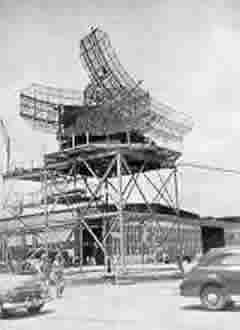 There are other stories, however, and in terms of the outcome of the war, they may have been just as important, though far less glamorous, as the deeds of the men in battle. One such story is told about the ingenuity of soldiers on the battlefield who were able to overcome obstacles through their own background knowledge and inventiveness. Countless American soldiers had been automobile mechanics, construction workers, electricians, engineers, and practitioners of many other such occupations. From time to time they were able to solve problems in combat that helped defeat the enemy. One famous example is that of an engineer who rigged up a device made of scrap metal from the Normandy beaches to help tanks get through the muddy irrigation fields and ditches in northwestern France, as was mentioned earlier.
There are other stories, however, and in terms of the outcome of the war, they may have been just as important, though far less glamorous, as the deeds of the men in battle. One such story is told about the ingenuity of soldiers on the battlefield who were able to overcome obstacles through their own background knowledge and inventiveness. Countless American soldiers had been automobile mechanics, construction workers, electricians, engineers, and practitioners of many other such occupations. From time to time they were able to solve problems in combat that helped defeat the enemy. One famous example is that of an engineer who rigged up a device made of scrap metal from the Normandy beaches to help tanks get through the muddy irrigation fields and ditches in northwestern France, as was mentioned earlier.
Another story is that of a group of men who rarely if ever saw a battlefield. They were the scientists in the university laboratories and research departments of large corporations who solved hundreds of technical problems that led to the creation of weapons and other tools that served American fighting men on land, at sea and in the air. One such group worked at the Massachusetts Institute of Technology to develop a variety of radar systems that spelled the difference between success and failure in the skies over Europe and the Pacific. One such radar device enabled British technicians to locate and defeat hundreds of the V weapons, known as “buzz bombs,” that Hitler sent over the British Isles in hopes of killing thousands of British civilians and bringing Great Britain to her knees.
Other radar devices helped pilots locate targets for their bombing missions, up to and including the dropping of the atomic bombs on Japan. Still others aided crippled aircraft, or bombers with wounded flight crews, to find their way back to a safe landing field. By the end of the war such devices were able to land planes even if the pilots could not see the field . (Many such devices, of course, found invaluable applications in civil aviation in the years following the war.)
The story of the creation of the atomic bomb at Los Alamos, New Mexico, has been told many times by observers and participants, and numerous films have illustrated the story as well. Biographies of men like J. Robert Oppenheimer have chronicled the heroic efforts of the scientists who worked feverishly to bring the weapon to completion in time to help the war effort. Although controversy still surrounds the dropping of the bombs on Hiroshima and Nagasaki, the consensus view is that they ended the war.
Far less well-known is the story of a man named Alfred J. Loomis, a millionaire scientist who built his own private laboratory at Tuxedo Park, New York. During the war he helped put together the team of scientists at MIT who created the radar devices that truly can be said to have won the war. The vast radar network upon which aviation safety depends has its roots in wartime radar development.
As mentioned above, nothing can detract from the heroism and bravery of the American fighting men and women who faced incredible challenges to defeat two determined and well-equipped enemies. Yet without the tools of combat provided to them by American scientists and engineers, their job would have been far more difficult if not impossible.
Presiding over that monumental effort of marrying military skill with scientific knowhow was Secretary of War Henry L. Stimson, one of the most remarkable political figures in American history. He began his career as United States Attorney for the Southern District of New York under Theodore Roosevelt and served as Secretary of War under President Taft. Over the next 30 years he held various other important posts, including the position of Secretary of State under President Herbert Hoover. As the threat of war neared in 1940 President Franklin Roosevelt named him once again Secretary of War, a post in which he served with great distinction until his retirement in 1945.
| World War II Home | Updated April 3, 2020 |